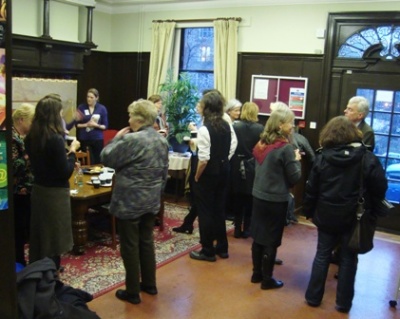Technical Studies Meeting December 5 2011

Research Network Technical Studies Meeting
The latest in the series of research network meetings, Technical Studies: Exploring Concept, Practices and Results, was held on 5 December 2011, a day which saw the first snow of the winter in Glasgow. As with previous network meetings, the 15 or so participants who gathered to discuss current and future research in the field came from a wide range of backgrounds. Most were from Scotland and England, with one contributor from Australia. Although the topic arose out of the Technical Art History strand of the network, the concept was extended to become truly interdisciplinary, encompassing the Textile Conservation and Dress and Textile History research strands.
Four of the participants gave brief presentations as a way of initiating discussion. They each discussed the investigation of particular objects or groups of objects, demonstrating how a technical study using a range of techniques had shed light on their original construction and subsequent history.
- Kate Gill (freelance conservator and researcher) described how reconstructing the complex wrapped thread buttons on a deliberately concealed man’s 17th century coat had given her an understanding of their construction.
- Nicola Costaras (Victoria & Albert Museum) and Erma Hermens (University of Glasgow) both described how a technical art historical approach to the study of paintings, combining documentary research with through investigation and technical analysis had helped to answer questions about the paintings’ provenance and purpose.
- Sally Tuckett (University of Edinburgh/National Museums of Scotland) explained how technical analysis of dyes used in sample books surviving from the Glasgow area’s Turkey Red dye industry could help to answer questions about the individual companies’ production.
The use of digital techniques to help create reconstructions was a recurring theme in these presentations.
Group discussion focused on several topics, with an emphasis on the characterisation of painted textiles, a key area of future research for the Centre for Textile Conservation and Technical Art History. Despite the different backgrounds of the participants, there were common concerns and interests including:
- The characterization of painted textiles.
- The borderline between paintings and painted textiles – this seems to have hardened over the centuries.
- 14th-16th century decorative painted cloths.
- Preserving the functionality of painted textiles such as furnishing or religious textiles, banners and scenery.
- The collation of source material for the study of painted textiles where the textiles themselves have not survived – in archives and collections, for example. The importance of oral history to capture memories of the textile industry.
- Investigation into linen used in canvas paintings.
- The development of new materials for fabric supports and linings for textiles and paintings, and the use of painting support materials for textiles.
- Non-destructive analysis of paintings and textiles.
We would like to extend our very warm thanks to everyone who took part in the discussions.
Frances Lennard
January 2012

